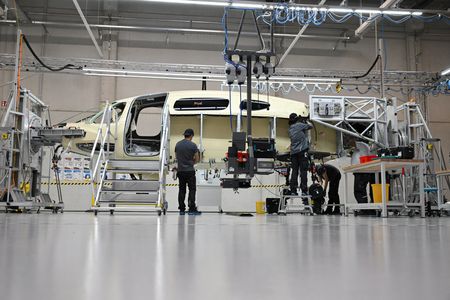LONDON (Reuters) -Euro zone manufacturing output grew at the fastest pace in just over three years in April despite overall factory activity remaining in contraction territory, with the big three economies showing signs of improvement, a survey showed on Friday.
HCOB’s euro zone final headline manufacturing Purchasing Managers’ Index (PMI), compiled by S&P Global, rose to 49.0 in April from 48.6 in March, marking its highest level in 32 months but remaining below the 50 mark separating growth from contraction.
“A fourth consecutive increase in the HCOB PMI can be seen as a sign that the situation in the manufacturing sector is stabilising. This comes as a surprise given the many uncertainties and shocks of recent months,” said Cyrus de la Rubia, chief economist at Hamburg Commercial Bank.
The output sub-index climbed to 51.5 from March’s 50.5, its highest since March 2022, indicating a second consecutive month of production growth despite weak demand.
New orders continued to fall but at their slowest pace in three years, nearly stabilising with the sub-index approaching the neutral 50 threshold at 49.5.
Export markets remained the primary weakness, with overseas orders declining more sharply than overall new business.
Germany, France and Italy – the bloc’s largest economies – all showed improvements, though their PMIs remained in contraction territory. Greece topped the table with a reading of 53.2, followed by Ireland at 53.0, while Austria languished at the bottom with 46.6.
“The near stabilisation of the industrial economy was helped by a production pick-up in both Germany and France in April, and Italy is fighting its way back into expansion territory,” de la Rubia added.
Factory employment fell for the 23rd consecutive month, although the rate of job shedding was the slowest since June.
Manufacturers managed to increase their profit margins as input costs declined for the first time since November while output prices rose at their fastest rate in two years.
The survey showed business confidence weakened to its lowest level in 2025 so far, signaling persistent caution among factory operators despite improving production trends.
A composite PMI, which includes the larger services sector and will be released next week, is expected to provide a more complete picture of the euro zone economy’s health.
(Reporting by Jonathan Cable)











